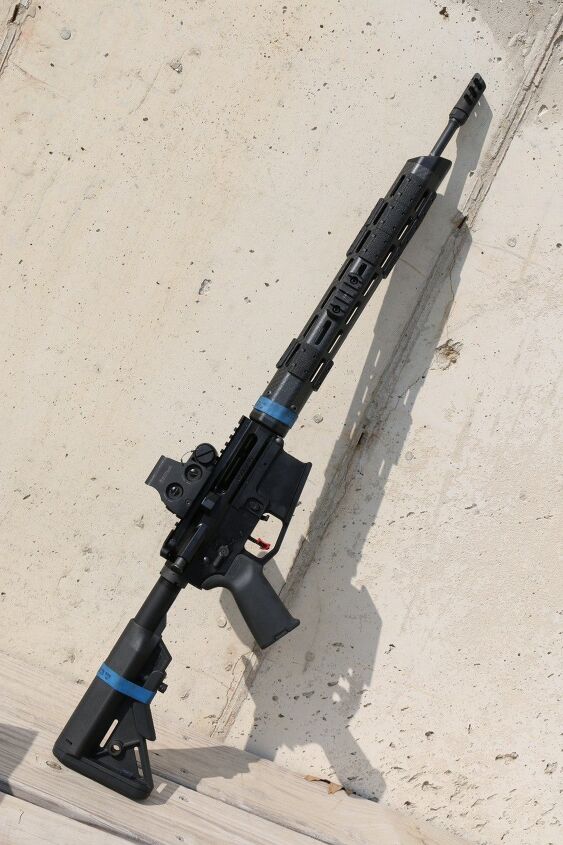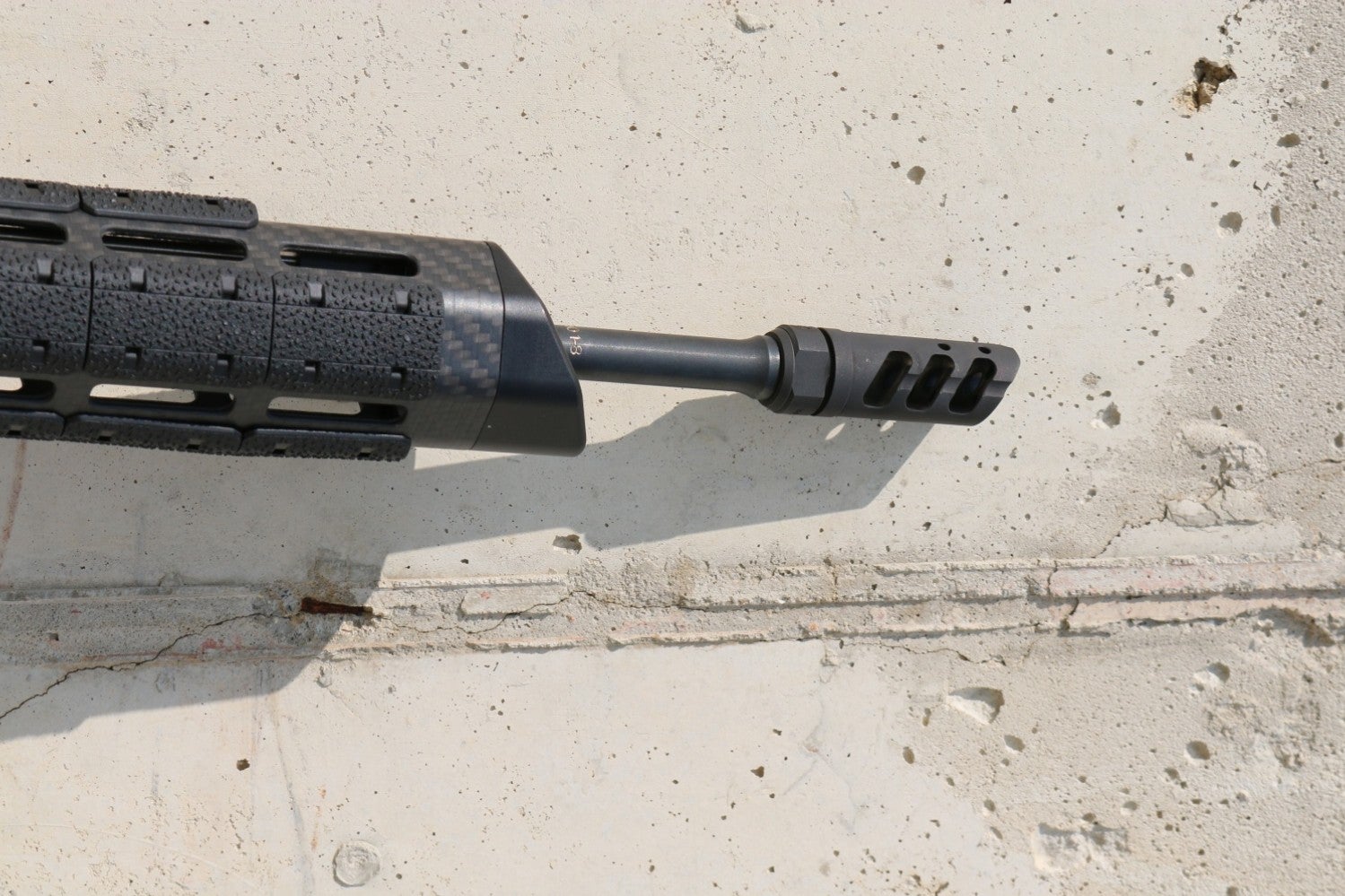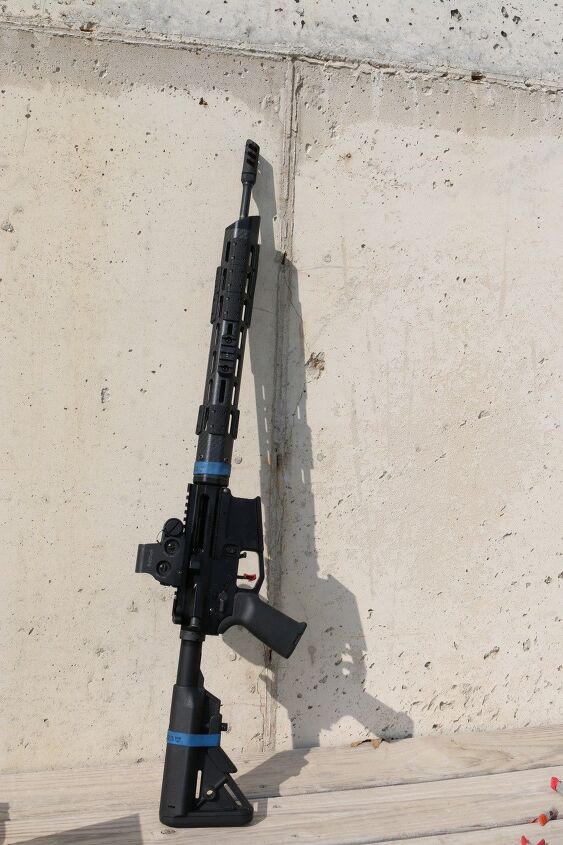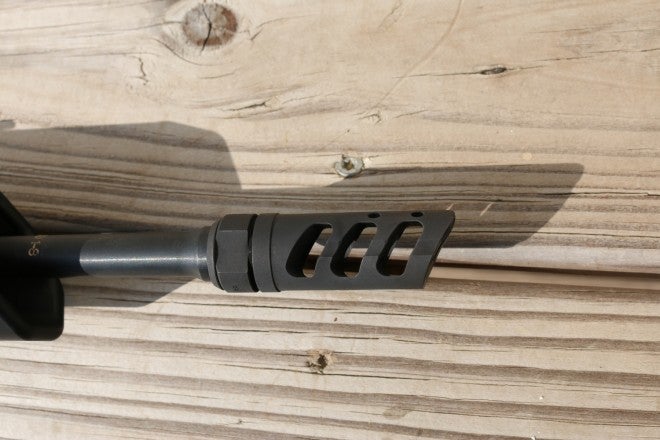While symptomatic for some time, I caught the competitive shooting bug badly last year. 3-gun started with a bone-stock ACR and has worked its way into a fully-fledged tuned AR-15 with nothing but competition-oriented parts. Alas, I have never been able to find a great muzzle device for the guns. The choices were either too heavy, bulky, loud, or drove the muzzle down on a shooter with proper posture.
It has been a long search, but I am very happy to have been sent one of the JL billet brakes for review. I will say it early into this lightning review, this brake is staying on the gun until “it dies, or I find something better.” (to quote a great movie).

The test platform: My personal 3-Gun AR.
Major Parts:
-Houlding Precision Receiver Set
-Faxon 18″ GUNNER barrel.
-Houlding 15″ Carbon Fiber Handguard
-Houlding Low-Mass Bolt Carrier
-EO Tech
-Adjustable Gas Block
-B5 Systems Stock
-HiperFire 24C Trigger
The JL Billet V.P.R. Brake Description from JL:
Our V.P.R. muzzle brakes are designed with varying degree port angles to redirect the gases out and up to reduce felt recoil as well as reduce the flash signature. We 5 axis CNC machine these from 303 stainless steel to get the proper port angles. The port angles start with a 15 degree back angle and decrease as the gases dissipate moving forward. This provides the shooter with a smooth feeling recoil reduction. 1/2-28 Threads
In case anyone was wondering, the V.P.R. stands for “Variable Port Recoil-Reduction”. The “variable” refers to the angle of the baffle in the brake, which increases farther down the brake.
Overview
The brake arrived in retail packaging. Its the usual non-descript clear plastic with a color-card backing that typifies the gun-shop wall. Inside the package is simply two objects, the brake and the crush washer. The packaging, while common, does a great job protecting the brake from shipment damage (which the box it arrived in was beat to dickens). The brake itself was impeccable. No machine marks, save the JL Billet logo on the top. Finish was top-notch, but matte (I rather hoped for a black luster nitride finish, but know that most barrels and devices are not). I won’t hold it against the brake.
As JL (rightfully should) brags about, the V.P.R. is precision machined on 5-axis mills. Using multiple axis, it gives JL significant ability to handle complex and variable shapes, which JL thankfully takes advantage of. The main exhaust ports are varying degrees (albeit minor differences), that takes significant advantage of a rearward angle to capture the most energy possible from the concussion.
The brake itself is rather diminutive. In fact, it’s nowhere near the maximum size that 3GN or most other circuits allow (1″ diameter, 3″ length from muzzle). The V.P.R. is only about .750″ x 1.5″. While making it bigger would allow it to deflect more energy and reduce recoil further, I am a fan of the designer’s choice.
The brake does have some compensation, using 5 strategically placed holes vertically near the baffles. This maximizes the blast going upwards by grabbing some of the energy displaced against the baffle. One vent is on the first baffle, central. The other four flank at 1 & 11 o’clock positions on the second and third baffles.
How it Fits My Shooting Rifle Philosophy
Now permanently afflicted by 3-GUN Disease I, like many, have developed certain treatments that assist with going faster, each based on a personal preference. My rifles are set up specifically to balance many factors, the primary ones being weight distribution, accuracy, and control-ability.
Often, the pursuit of one leads to the detriment of the others, especially when brakes start getting involved. In the case of many brakes that I have tested out, they are often very large (ie heavy) and while that does help with recoil reduction, most targets require movement of the muzzle from one to the next. The heavier the brake, the more weight out front (especially the longer a barrel gets), the more unwieldy the weapon. As I am not afraid of recoil, being 250+ lbs, I care most about the fluid motion of the muzzle.
Further, other brakes tend to also over-compensate for muzzle-rise, opting to push the muzzle down as if the designers assume that the shooter does not know how to square-up on the gun and target. For the general market, this may be a good decision, but for me, its annoying as I have to lift the muzzle after each shot costing precious time.
Given its balance of size, recoil reduction, and muzzle control, I am absolutely in love with this piece of metal. It fits me perfectly.
The Good:
- Solid recoil reduction.
- Great machining. No marks and arrived in perfect condition.
- Low weight and profile. Rifle stays easy to swing.
- Keeps muzzle flat without over compensating vertically.
- Nearly enclosed first blast chamber for fantastic recoil management.

Looks great on the tip of a 3-gun oriented barrel.
The Bad:
- Price is up there for a muzzle brake. Retails for $109.95 direct from JL Billet.
- The forward swept angle and side cuts may not be for everyone aesthetically.
- Why holes up front? Close them up to reduce recoil just that smidgen further.

I don’t get the holes up front. Why release gasses when you can capture them for more recoil reduction?
The Notable:
- Still requires a crush or similar washer system.
- Finish was matte. Those with a luster-styled nitride barrel (like the one I had) will find it doesn’t match up perfectly. Those with a manganese phosphate finish or matte finished barrel will find it a natural extension.

Looking down the side of the handguard.
Conclusion:
First and foremost, I demand a product perform: The JL does it well. Second, I look for weight and feel, and likewise, the V.P.R. steps up and performs without adding too much weight or affecting the “swing” of the rifle. Third, I look for aesthetics and price. Both are high.
As such, it’s a compelling option, especially for those who prefer how a rifle swings versus those shooting for maximum recoil reduction.
On my personal competition rifle, the brake will be staying attached. As a picky shooter, that’s the highest praise I can give.

Looks like it belongs.
 Your Privacy Choices
Your Privacy Choices
